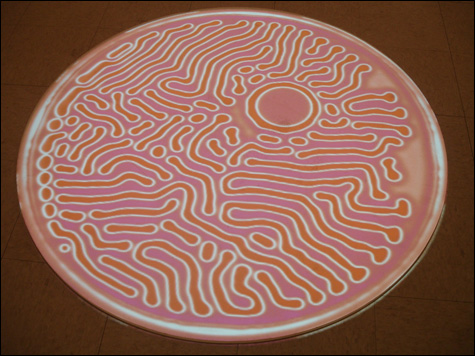
FLOWER (REVEALED): At “It’s Alive,” Boston artist Brian Knep seems on the cusp of a breakthrough.
|
These are mostly one-liner illustrations of warnings about bio-tech, complaints we were familiar with before we walked in. The exceptions are two installations by Brian Knep, one of the most exciting artists in Boston right now. In Drift (2004), digitally animated bubbles drift across five squares painted on the gallery wall. They morph as they flow from one square to the next — circular bubbles becoming long bubbles becoming big blobs becoming spaghetti-like strands becoming round blobs again. In Flower (Revealed) (2005), an electronic pattern — something between zebra stripes and leopard spots — is projected onto a low circular platform on the floor. Step on it and a watching camera creates a “wound” where you stood. Then spots radiate and bubble up around and into this gap, like something spawning in a sci-fi thriller.
Knep’s designs seem alive. They evoke the feeling of nervousness, but also our wonder at our ever more technological world. And they’re fun to look at as well. His stuff reminds me of the energy around the video art Tony Oursler was making here when he taught at MassArt in the early ’90s. Knep seems on the cusp of his own big breakthrough.
The virtual world is the subject of Internet-based artworks in “Personal Computer” at Second Gallery. In New Yorker John Michael Boling’s Ebay Asteroids (2006), buttons and graphics from the eBay Web site jitter diagonally across the screen (in this case projected on the gallery wall) like objects in the old video game Asteroids. He reworks Google’s homepage in Lord of the Flies (2006) so that a swarm of arrows drift like schooling fish up toward the Google logo as the dreamy themesong from the ’90s television series Twin Peaks plays.
Mark Callahan of Georgia makes Internet Soul Portraits by stripping the identifying text and logos from popular Web pages — Yahoo, Google, MSN, eBay, MapQuest, MySpace. The pages become familiar-feeling but strangely anonymous diagrams with shopping-cart icons floating here and there. New Yorker Charles Brokoski’s The MySpace Biennale (2006) turns bits of design from MySpace into patterns. Each pattern has its own page — and they’re all linked like a MySpace social network.
Like Aaron Siskind in his photo abstractions, these guys foreground the junk in our landscape — in this case the Internet — that we usually ignore. It’s not the most compelling-looking art, but it leads me to wax philosophical about how we interface with the Web, about all the computer detritus that we take for granted.
‘Karen Finley: Nation Building’ | Huret and Spector Gallery | Emerson College, 10 Boylston Place [Sixth Floor], Boston | Through April 18
‘It’s Alive! A Laboratory of Biotech Art’ | Montserrat College of Art | 23 Essex St, Beverly | Through April 7
‘Personal Computer’ | Second Gallery, 516 East 2nd St, Boston | Through April 15